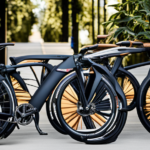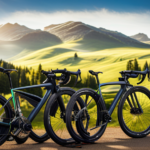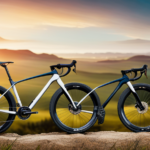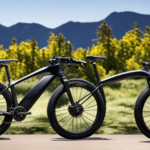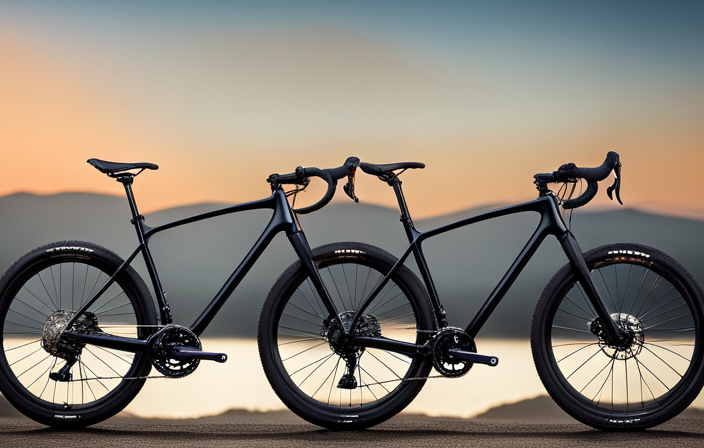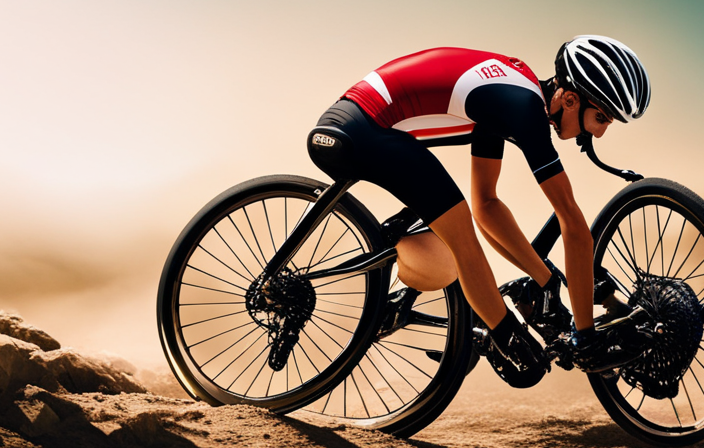Looking for a bike that can handle both gravel and pavement surfaces can seem like trying to find a needle in a haystack. But don’t worry, fellow adventurers! I am here to help guide you on this exciting journey.
Like a compass pointing you in the right direction, this article will provide you with all the knowledge and expertise needed to navigate through the vast world of bikes.
So let’s saddle up, strap on our helmets, and embark on this exciting quest to find the ultimate bike that effortlessly glides over gravel and pavement alike.
Key Takeaways
- Aggressive riding style requires nimble handling characteristics and benefits from a bike with quick and responsive handling.
- Gravel roads require wider tires with more tread patterns for improved stability and grip.
- Pavement benefits from smoother tires with lower rolling resistance for faster speeds.
- A lightweight aluminum frame offers versatility for both terrains, but can transmit more vibrations from rough surfaces.
Determine Your Riding Style and Terrain
To find a bike good for gravel and pavement, you need to determine your riding style and the terrain you’ll be tackling. Riding techniques play a crucial role in this decision-making process. If you prefer a more aggressive style with faster speeds and tight turns, a bike with nimble handling characteristics would be ideal. On the other hand, if you enjoy a more relaxed approach with leisurely rides, then comfort should take precedence.
Once you’ve identified your riding style, it’s important to consider the right tires for your chosen terrain. Gravel roads require wider tires with more tread patterns to provide better traction and stability on loose surfaces. Pavement, on the other hand, benefits from smoother tires that offer lower rolling resistance for faster speeds.
Transitioning into considering the bike frame material, it’s essential to choose one that suits both gravel and pavement riding. A lightweight aluminum frame offers excellent versatility as it is durable enough to handle rougher terrains while providing efficient power transmission on smooth surfaces like pavement.
By understanding your riding style and terrain preferences along with selecting appropriate tires and frame materials, you can ensure finding a bike that excels both on gravel trails and paved roads without compromise.
Consider the Bike Frame Material
When considering a bike suitable for both gravel and pavement, it’s important to take into account the frame material. Different frame materials offer distinct advantages and disadvantages, so understanding the pros and cons of each can help you make an informed decision.
One popular frame material is aluminum. It is lightweight, affordable, and provides excellent stiffness, which translates into efficient power transfer. However, aluminum frames can be less comfortable due to their stiffness, transmitting more vibrations from rough surfaces.
Another option is carbon fiber. This material offers superior vibration damping properties compared to aluminum, resulting in a smoother ride on uneven terrain. Carbon frames are also lighter than aluminum ones while maintaining sufficient stiffness for optimal performance. However, they tend to be more expensive.
Steel frames are known for their durability and comfort. They absorb road vibrations effectively and provide a smooth ride experience on both gravel and pavement. However, steel frames can be heavier compared to aluminum or carbon options.
Considering these factors, the best bike frame material for gravel and pavement biking depends on your preferences regarding weight, comfort level, budget constraints, and overall riding style.
Now that we have discussed bike frame materials comparison in detail, let’s move on to choosing the right bike size…
Choose the Right Bike Size
Determining the correct size of your bicycle is crucial for a comfortable and enjoyable riding experience. Bike fit plays a significant role in preventing discomfort, pain, or even injury while riding on different terrains.
When it comes to bike sizing, there are various factors to consider. The first step is to measure your inseam length, which is the distance from your crotch to the floor. This measurement helps determine the appropriate frame size for you. Additionally, considering your height and arm length can further refine your choice.
Once you have narrowed down the frame size options, it’s essential to test ride different bikes before making a final decision. This allows you to assess how well the bike fits your body and riding style. A proper bike fit ensures that you can reach the handlebars comfortably without straining your back or shoulders.
In conclusion, determining the right bike size is vital for an optimal riding experience on both gravel and pavement surfaces. By considering factors such as inseam length, height, and arm length, you can find a bike that suits your body proportions perfectly.
With this knowledge about bike sizing in mind, let’s now explore another important aspect: looking for wide tires with tread patterns that provide excellent traction on various terrains.
Look for Wide Tires with Tread Patterns
For the best riding experience, you should consider opting for wide tires with tread patterns that provide excellent traction on various terrains. Wide tires offer a number of advantages when it comes to riding on both gravel and pavement surfaces.
Here are three reasons why wide tires with tread patterns are a great choice:
-
Improved stability: Wide tires offer increased stability, especially when encountering uneven or loose surfaces such as gravel. The wider contact patch provides better balance, allowing you to navigate through different terrains with confidence.
-
Enhanced grip: Tread patterns on wide tires help improve traction by providing additional grip on both gravel and pavement. This means you can maintain control of your bike regardless of the surface conditions.
-
Comfortable ride: Wide tires also contribute to a more comfortable ride due to their ability to absorb shocks and vibrations from rough roads. This can greatly reduce fatigue during longer rides.
When considering tire pressure recommendations, it’s important to note that lower pressures are often recommended for off-road riding on gravel, while higher pressures are suitable for smoother pavements. Additionally, another option worth considering is tubeless tires which have become increasingly popular in recent years. Tubeless setups provide benefits such as improved puncture resistance and the ability to run lower tire pressures without risking pinch flats.
To enhance your biking experience even further, consider suspension or shock absorption systems that can help dampen impacts from rough terrain or bumps along the way.
Consider Suspension or Shock Absorption
To enhance your biking experience even more, you should consider adding suspension or shock absorption systems to help smooth out any rough terrain you may encounter. When it comes to choosing a bike for both gravel and pavement, the decision between suspension and rigid frames can greatly impact your ride quality. Suspension systems, typically found in mountain bikes, are designed to absorb shocks and bumps, providing a smoother and more comfortable ride on uneven surfaces. On the other hand, rigid frames lack this feature but offer better efficiency on paved roads due to their lightweight design.
Here’s a comparison of suspension vs rigid frames:
| Suspension | Rigid |
|---|---|
| Absorbs shocks and vibrations | More efficient on paved roads |
| Provides better control and traction | Lightweight design for easy maneuverability |
| Reduces fatigue on long rides | Requires less maintenance |
By opting for a bike with suspension or shock absorption, you can enjoy numerous advantages. Firstly, these systems provide better control and traction when riding over gravel or bumpy terrain. They absorb shocks and vibrations caused by uneven surfaces, reducing fatigue during longer rides. Additionally, suspension helps maintain contact between the tires and the ground, improving stability and preventing accidents.
Transition: Now that we’ve explored the benefits of suspension or shock absorption systems, let’s delve into another important feature: disc brakes for better control.
Opt for Disc Brakes for Better Control
If you want to improve your control while biking, consider opting for disc brakes. Disc brakes offer several advantages over traditional rim brakes, especially when it comes to riding on gravel and pavement. Here are three reasons why disc brakes can enhance your biking experience:
-
Enhanced stopping power: Hydraulic disc brakes provide superior stopping power compared to rim brakes. This means you can stop more quickly and effectively, giving you better control in various riding conditions.
-
Consistent performance: Disc brakes are not affected by wet or muddy conditions like rim brakes. They maintain consistent braking performance regardless of the weather, ensuring reliable control on both gravel and pavement surfaces.
-
Increased durability: Disc brake pads last longer than traditional brake pads, reducing the need for frequent replacements. This saves you time and money in the long run while ensuring optimal braking performance on all terrains.
To maintain your disc brakes and maximize their lifespan, follow these tips:
- Regularly inspect the brake pads for wear and replace them as needed.
- Keep the rotors clean from dirt and debris.
- Bleed the hydraulic system occasionally to ensure proper functioning.
When it comes to finding a bike suitable for both gravel and pavement, paying attention to gear ratios is crucial. Transitioning smoothly into this topic…
Pay Attention to Gear Ratios
When it comes to finding the perfect bike for gravel and pavement, there are a few key factors to consider. In the previous section, we discussed the importance of opting for disc brakes for better control. Now, let’s shift our focus to another crucial aspect: gear ratios.
Gear ratios play a vital role in determining how efficiently you can pedal your bike on different terrains. When riding on gravel, you’ll want lower gears that provide more torque and allow for easier pedaling. This is because gravel surfaces tend to be looser and require extra power to maintain traction. On the other hand, when riding on pavement, higher gears are preferable as they allow you to achieve greater speeds with less effort.
Calculating gear ratios involves comparing the number of teeth on your front chainring with those on your rear cassette. By choosing a bike with a wide range of gear options, you can easily adjust your cadence and find the perfect gear ratio for any given terrain.
Now that we understand the importance of gear ratios in different terrains, let’s move on to considering the bike’s weight and portability. After all, these factors also play a significant role in determining your overall riding experience without compromising performance.
Consider the Bike’s Weight and Portability
Considering the weight and portability of a bike is crucial for ensuring a comfortable and convenient riding experience. When searching for a bike that can handle both gravel and pavement, it’s important to find one that strikes the right balance between being lightweight and easy to transport.
Here are four key factors to consider when evaluating the weight and portability of a bike:
-
Frame material: Opt for lighter materials like aluminum or carbon fiber, which offer strength without adding unnecessary weight.
-
Folding capability: Look for bikes with folding mechanisms that allow you to easily collapse and store them in compact spaces, making transportation hassle-free.
-
Wheel size: Smaller wheels tend to be lighter and more maneuverable, making them ideal for commuting on pavements as well as tackling rougher terrain.
-
Carrying options: Consider bikes with built-in racks or mounts that allow you to attach panniers or bags so you can carry essentials during your rides.
By taking these factors into account, you can find a bike that not only performs well on both gravel and pavement but also offers the convenience of easy transportation.
With this in mind, let’s explore another important aspect – looking for versatile handlebars – which will further enhance your riding experience.
Look for Versatile Handlebars
To enhance your riding experience, make sure to prioritize handlebars that offer versatility. Versatile handlebar options can greatly improve your comfort and control while riding on both gravel and pavement. When it comes to handlebar materials for gravel riding, there are a few popular choices to consider.
One option is the drop handlebars, commonly found on road bikes. These handlebars provide multiple hand positions, allowing you to change your grip and posture for different terrains. They also offer good aerodynamics when riding on pavement.
Another option is the flat handlebars, which are often seen on mountain bikes. These bars provide a more upright position, giving you better visibility and control over rough terrain. They are also compatible with various accessories like lights and phone mounts.
Lastly, there are also hybrid handlebars that combine elements from both drop and flat bars. These bars offer a compromise between the two styles, providing a comfortable grip position for long rides while still allowing for off-road capabilities.
When choosing a bike for gravel and pavement, considering the type of handlebars is crucial in ensuring an enjoyable ride. However, don’t forget to check for mounting points for accessories as well.
[//]: # (Table)| Handlebar Type | Description | Suitable Terrain |
|---|---|---|
| Drop Handlebars | Multiple hand positions; good aerodynamics | Pavement |
| Flat Handlebars | Upright position; better control over rough terrain | Gravel |
| Hybrid Handlebars | Combination of drop and flat bars; versatile grip positions | Mixed |
Now that we’ve covered versatile handlebar options and their benefits, let’s move on to checking for mounting points for accessories in the next section
Check for Mounting Points for Accessories
Now that we’ve covered the importance of versatile handlebars, let’s move on to another crucial aspect when looking for a bike that is good for both gravel and pavement: checking for mounting points for accessories.
These mounting options are essential because they allow you to customize your bike according to your needs and preferences. Having adequate mounting points ensures that you can easily attach accessories such as racks, fenders, water bottle cages, or even bikepacking bags. This way, you can carry all the gear necessary for your adventures without compromising comfort or safety. Look for bikes with multiple mounting options on the frame, fork, and seat stays to maximize accessory compatibility.
In addition to providing convenience, these mounting points also enhance the versatility of your bike. You can switch between different setups depending on whether you’re going on a long-distance tour or a quick commute around town.
Consider bikes with threaded eyelets or braze-ons as they offer more secure attachment points compared to clamps or straps. These small details make a big difference when it comes to durability and longevity in all types of riding conditions.
Transitioning into the next section about considering the bike’s durability and longevity…
Consider the Bike’s Durability and Longevity
When searching for a versatile bike, it’s important to take into account its durability and how long it will last. This is especially crucial when considering a bike that can handle both gravel and pavement surfaces. The durability of the bike will determine its ability to withstand the challenges posed by these different terrains. You want a bike that can handle rough gravel paths without compromising its performance on smooth pavements.
Finding the right balance between durability and performance is key. Look for bikes made from high-quality materials like aluminum or carbon fiber, as they are known for their strength and longevity. These materials are lightweight yet sturdy, allowing you to navigate through various terrains with ease.
Additionally, consider the components of the bike such as the wheels, tires, and drivetrain. Opt for durable wheels with wider tires that provide better traction on gravel while still maintaining efficiency on pavement. A reliable drivetrain with quality gears will ensure smooth shifting and efficient power transfer.
By considering the bike’s durability and longevity, you’ll be able to find a dependable ride that can handle both gravel and pavement surfaces effectively. Now let’s move on to the next step – read reviews and get recommendations – to gather more information before making your final decision.
Read Reviews and Get Recommendations
Check out reviews and get recommendations from experienced riders to gather valuable insights before making your final decision. One of the best ways to find a bike that is good for both gravel and pavement is to tap into the knowledge of those who have already tested out different models. Getting advice from experienced riders can help you understand which bikes perform well on various terrains, and which ones may not live up to their claims.
To start your research, join online biking communities where you can connect with fellow cyclists and ask for recommendations. These communities are full of passionate riders who are more than willing to share their experiences and offer suggestions based on your specific needs. Their first-hand knowledge can save you time and money by pointing you in the right direction.
Additionally, reading reviews from reputable sources such as cycling magazines or websites can provide valuable information about a bike’s performance, durability, and overall quality. Look for detailed reviews that discuss how the bike handles on different surfaces, its components’ reliability, and any potential drawbacks.
By gathering insights from experienced riders and trusted sources, you will be better equipped to make an informed decision when choosing a bike for gravel and pavement riding. With this knowledge in hand, it’s time to move on to the next step: test ride multiple bikes at local shops or events.
Test Ride Multiple Bikes
To get a feel for different options, try out multiple bikes by test riding them at local shops or events. Test riding is one of the best ways to determine if a bike is suitable for both gravel and pavement.
There are several advantages to test riding before making a purchase. Firstly, it allows you to experience firsthand how the bike handles different terrains. You can see how it performs on rough gravel roads as well as smooth paved surfaces. This will give you an idea of its versatility and whether it meets your specific needs.
When test riding, pay attention to the bike’s stability and comfort. Is it easy to maneuver? Does it provide a smooth ride? These are important factors when considering a bike that can handle both gravel and pavement effectively. Additionally, take note of the gears and brakes, ensuring they are responsive and reliable.
To make the most out of your test ride, here are some tips: start with shorter rides around the shop or event area; vary your speed and terrain; try out different bikes within your budget range; ask questions about each bike’s specifications.
Once you have completed your test rides, comparing prices and looking for deals is the next logical step in finding the ideal bike for gravel and pavement adventures. By doing so, you can ensure you get the best value for your money while still meeting all your biking needs without compromise.
Compare Prices and Look for Deals
Comparing prices and searching for discounts can help you get the most value out of your purchase for a bike suitable for both gravel and pavement. When looking to buy a bike, it’s important to do your research and compare prices from different retailers. This will give you an idea of the average cost for the type of bike you’re interested in. Additionally, keep an eye out for any deals or promotions that may be available. Many retailers offer discounts on bikes, especially during certain times of the year.
To assist you further in comparing prices and finding the best deals, I have created a table below that compares the prices of popular brands known for their quality gravel and pavement bikes:
| Brand | Model | Price |
|---|---|---|
| Trek | Checkpoint ALR 4 | $1,599 |
| Specialized | Diverge Base E5 | $1,100 |
| Giant | Revolt Advanced 2 | $2,000 |
| Canyon | Grail CF SL 7.0 | $2,499 |
By researching these brands and models, you can make an informed decision based on both price and quality.
Now that you have compared prices and found potential options within your budget, it’s time to consult with a bike expert or visit your local bike shop. They can provide valuable insights into which bike would be the best fit for your needs and preferences while considering factors such as frame material, components, and sizing options.
Consult with a Bike Expert or Local Bike Shop
Once you’ve compared prices and potential options within your budget, it’s a good idea to consult with a bike expert or visit your local bike shop for valuable insights.
A bike expert consultation can provide you with in-depth knowledge about different types of bikes suitable for both gravel and pavement. These experts have extensive experience and can guide you towards the right choice based on your preferences and riding style.
When you visit a local bike shop, you not only get access to a wide range of bikes but also the expertise of their staff. They can recommend specific models that are well-suited for gravel and pavement riding. Moreover, they can help you understand the key features and components that make these bikes ideal for versatile terrain.
During the consultation, be sure to discuss your intended usage, such as whether you plan on primarily riding on gravel or pavement or a combination of both. The bike expert will then consider factors like tire width, frame material, suspension options, and gear ratios to suggest the most suitable options.
In addition to providing personalized recommendations, visiting a local bike shop allows you to test ride different bikes before making your final decision. This firsthand experience is invaluable in helping you find a bike that feels comfortable and performs optimally on both gravel roads and paved surfaces.
Overall, consulting with a bike expert or visiting your local bike shop is an essential step in finding the perfect bike for both gravel and pavement riding. Their expertise will ensure that you make an informed decision while considering all aspects of performance, comfort, durability, and price point.
Frequently Asked Questions
Can I use a regular road bike for gravel riding?
Yes, you can use a regular road bike for off-road trails, including gravel riding. However, it’s important to note that a gravel bike is specifically designed for this type of terrain and offers several advantages over a road bike.
A gravel bike features wider tires with more traction and stability, a more relaxed geometry for better handling on uneven surfaces, and increased clearance for mud and debris. These features enhance the overall performance and comfort when riding on gravel roads.
What is the ideal weight range for a gravel bike?
Oh, the ideal weight range for a gravel bike, what a fascinating topic! When it comes to these versatile machines, you’ll find that lighter isn’t necessarily better. In fact, a slightly heavier frame can provide more stability and durability on those rough gravel roads.
Generally speaking, the ideal weight range for a gravel bike falls between 20 to 25 pounds. This allows for a balance between agility and strength, ensuring an enjoyable ride no matter the terrain.
Are there any specific handlebar types that are recommended for gravel and pavement riding?
There are a few handlebar types that are recommended for gravel and pavement riding. One popular option is the drop bar, which provides multiple hand positions for comfort on long rides.
Another option is the flat bar, which offers better control and stability on rough terrain.
When choosing tires, consider getting ones with a mixed tread pattern that provide grip on both gravel and pavement surfaces.
Additionally, selecting a frame material like aluminum or carbon can offer durability and responsiveness on different terrains.
How important is suspension or shock absorption for riding on gravel and pavement?
Suspension or shock absorption is not crucial for riding on gravel and pavement. The importance lies in having the right tire width. Wider tires provide better stability, traction, and comfort on rough surfaces like gravel.
However, using a hardtail mountain bike has its pros and cons. While it offers efficiency and speed on pavement, it may lack the necessary cushioning for long rides on bumpy terrains.
Consider your priorities before choosing the bike that suits your needs best.
What are some common accessories that can be mounted on a gravel bike?
Some common accessories that can be mounted on a gravel bike include bikepacking gear and tubeless tires.
Bikepacking gear is essential for carrying all your camping necessities, such as a tent, sleeping bag, and cooking equipment. It usually includes frame bags, saddle bags, and handlebar bags designed to fit securely on the bike.
Tubeless tires are a great addition because they provide better traction and reduce the risk of punctures when riding on rough terrain like gravel roads.
Conclusion
In conclusion, finding the perfect bike for both gravel and pavement can be a challenging task. However, by considering your riding style, terrain, and frame material, as well as looking for wide tires with tread patterns and suspension options, you can narrow down your options.
Reading reviews, test riding multiple bikes, and comparing prices will also help make an informed decision. Remember to consult with a bike expert or visit your local bike shop for additional guidance.
So why wait? Get out there and find the bike that suits your needs best!


